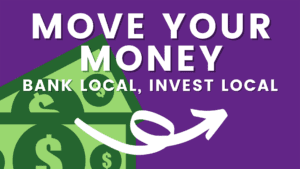
Make your emails like cupcakes: welcomed, tasty, not too big, easy to consume on the go, and smile-worthy. Photo (CC) by squeezeomatic on Flickr.
Many small businesses collect email addresses from their customers, but they never do anything with them. That’s a missed opportunity. Other small businesses have built their entire presence on Facebook, so they have no control over who does or does not get their messages.
Email remains a tool that you control. You decide when to send a message, and it will get delivered to almost everyone on your list. Customers recognize your name, and they’re more likely to open your emails because you’re local. So it’s easier for you to get your emails read.
What to say:
Have something valuable to share before you ever write a word. Sit down and brainstorm. Talk to some customers. Ask them what they’d like to receive. Liquor stores can send drink recipes. Accountants can send tips for dealing with paper receipts in the digital age. Personal trainers can send exercises you can do in your chair, or while on the go. Your topics can be anything your customers tell you would be useful.
Talk more about them and less about you. What do customers want? What do they worry about? What difference will it make if they read this email? What’s in it for the customer? New product announcements are OK, but they aren’t as good as a story about a customer.
Be your most friendly small town self. Be personal. Write it like you’d talk to one person. Use your accent. Don’t try to sound generic, corporate, big or important. Just be you. Customers already like you, right?
Put your message into the body of the email. Do not attach anything in PDF. Most of your readers are opening your email on their phone. How do you think your PDF will look on my phone? Not so hot! So just say what you have to say in the body of the email. The only exception to the “no PDF” rule is for something the reader will want to print. So a chamber of commerce could send out a flyer to print and post in PDF. But the newsletter itself should be in the body of the email.
Permission:
Make sure people know they are signing up for your newsletter. Don’t add people without their permission. If you have a list of email addresses you’ve collected more than 3 months ago but have never emailed, don’t use them. Better to start with people who know what they are getting and want to get it.
Make it easy to sign up and give customers are reason. Put a sign up form on your website. Use an iPad to take signups at your business and anywhere else you and your customers are in person. State the reason or the benefit for signing up. For example, “Want quick and easy fitness tips in your email? Put your email address here.”
Never, never, never use anyone else’s email list. Don’t borrow a list from the chamber, or copy a list from a group, or add people in any way except when they specifically ask to get email from you. We all get too much email we don’t want. So make sure you only email to people who have told you that they definitely do want to hear from you.
Technical:
Use an email service like MailChimp. You can start out for free until you get over 2,000 names. It’s easy to use. It takes care of or solves the technical issues I’m about to list. I use it myself, and I recommend it for small businesses. That is an affiliate link, meaning I would get credit if you became a paying customer of MailChimp. Other email providers are also great, but I don’t have direct experience with them. Feel free to mention your favorite in the comments section below.
Do not send email to your mailing list from your regular email account. It’s hard to manage any unsubscribes or changes to the list members, your emails may be caught by more spam filters, and you can’t easily track or analyze your success. If you fail to use “BCC” to hide the recipients, you’ve exposed every customer’s email address, and anyone can hit “reply all” and annoy everyone on the list.
Do not use “listserv” type services. Listservs automatically forward any email they receive to the entire list. They’re great for discussion groups, terrible for businesses. Your website host might offer one, called LISTSERV, Mailman or just Mailing List. The person who maintains your website might offer to use one of these for your marketing emails. Say no.
Why permission and tech matter
A local business borrowed or paid to borrow a list from a big membership organization. (Mistake #1: using someone else’s list.) Helped by their website person, they put everyone into a listserv. (Mistake #2: not using an email service like Mail Chimp.) Then they sent one email advertising their business to the list.
Because people were added to this list without their permission, they started replying asking to be removed. Because it was a listserv, all those emails went to everyone on the list. So more people replied to be removed, too. Those emails went to everyone. Soon, dozens of emails were going to the entire list. People got angry about receiving all these emails. They replied with rude and hateful emails. The listserve sent those emails to the entire list, too. This went on all day long. I found out because my husband was one of the people on the list, bombarded with hundreds of pointless emails before the business and their website person shut down the listserv. It was a pretty dramatic example of why you don’t want to use a listserv and why not to borrow a list from someone else.
Your tips
When you do email right, it is a great tool for small businesses. It’s even more effective in small towns where you start out with stronger ties to your customers.
If you use email for your small town business, what have you learned that will help others? Share in the comments section below.
New to SmallBizSurvival.com? Take the Guided Tour. Like what you see? Get our updates.











Completely agree with your points, but with an addition. If a local business sends me an email, I’m tremendously more inclined to open and read than normal (so I’m not so sure the normal “click rates” would apply to small home town businesses).
I’m actually on a list that a single individual sends out as part of his business. He does it on a scheduled basis (once a month), and I like to read it so much that I have a filter set up just for that so I don’t miss it. How stinking valuable is that to a business?
Chad, that is a terrific example of our advantage as local small businesses. No big corporation can match it.
Also, make sure that the newsletter is interesting enough that people keep reading. I have signed up for some newsletters myself and I must say that most are not that good. It is important to really put some time into creating a good newsletter for it to be valuable to readers.
Absolutely true, Ivan.